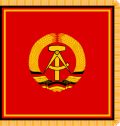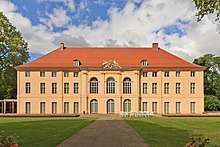| President of the German Democratic Republic | |
|---|---|
 | |
| Residence | Majakowskiring 29, Pankow, East Berlin |
| Seat | Schönhausen Palace, Pankow, East Berlin |
| Appointer | People's Chamber Chamber of States |
| Precursor | The Reichspräsident |
| Formation | 11 October 1949 |
| First holder | Wilhelm Pieck |
| Final holder | Wilhelm Pieck |
| Abolished | 7 September 1960 |
| Superseded by | State Council of East Germany |
| Deputy | President of the People's Chamber |
 |
|---|
The president of the German Democratic Republic (German: Präsident der Deutschen Demokratischen Republik) was the head of state of the German Democratic Republic, commonly known as East Germany, from 1949 until 1960.[1] The office was created by the Constitution of 1949 (Section V). The president of the Republic was elected by the People's Chamber (Volkskammer) and the Chamber of States (Länderkammer), the two chambers of parliament. The office was mostly ceremonial in nature. If necessary, the President of the Volkskammer acted as the president of the Republic.
The sole incumbent was Wilhelm Pieck of the Socialist Unity Party of Germany (SED), elected on 11 October 1949[2] and re-elected in 1953 and in 1957. Shortly after the death of Pieck on 7 September 1960, the Constitution was amended. The Law concerning the formation of the State Council of 12 September 1960 introduced a collective head of state instead of the presidency, the State Council of East Germany. In the last, pro-Western phase of East Germany in 1989/90, the State Council was abolished; President of the People's Chamber Sabine Bergmann-Pohl acted as interim head of state.
- ^ Cook, Bernard A. (2001). Europe Since 1945: An Encyclopedia. Taylor & Francis. p. 1284. ISBN 9780815340584.
- ^ Wilhelm Pieck timeline Retrieved 10 June 2010 (in German)
